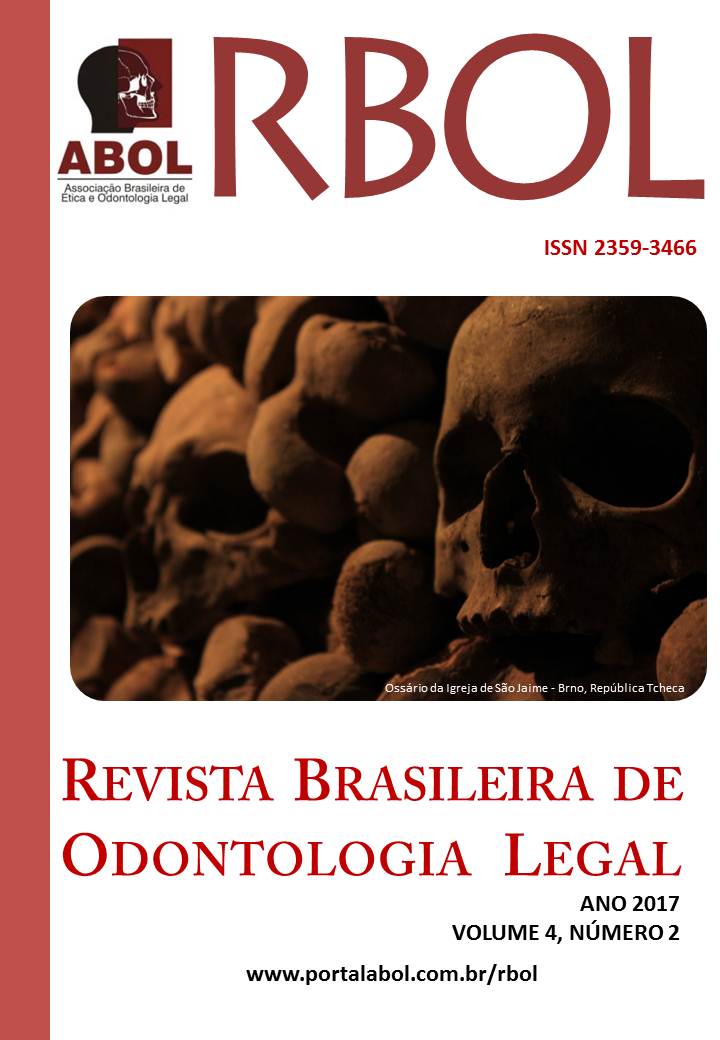REALITY OF FORENSIC ODONTOLOGY IN SAUDI ARABIA
DOI:
https://doi.org/10.21117/rbol.v4i2.106Palabras clave:
Saudi Arabia, Forensic dentistry, Bites and stings, Expert witness, Age estimation by teethResumen
Saudi Arabia (SA), an oil rich developing country with a population of 31 million people, yet only 33% of whom are Saudis. Wealth, work opportunities and religious status make SA a hub for people from around the world whether it be through legal or illegal routs. As a developing country, SA faces many challenges in regard to mass disasters in light of its underdeveloped infrastructure and the annual Haj (Islamic pilgrimage) that attracts nearly 3 million people in a small area over a short period of time. Moreover, the numbers of unregistered births is high. These factors necessitate the importance of having a strong human identification and age estimation practice. Aim: To assess the reality of Forensic Odontology in Saudi Arabia in regard to: number of personnel and their training, number of forensic odontology cases and the way these cases are referred and documented. Materials and Methods: This project consisted of two parts: Observational study to assess how the system works in regard to forensic odontology cases, how these cases are dealt with and how they are referred. Part two: Cross-sectional survey aimed at all registered Forensic personnel to assess their qualifications, training, level of expertise, expert witness experience and involvement in specialized Forensic Odontology cases, namely: human identification, age estimation and bite mark analysis. Results: Out of 51 participants, only one dentist is registered with some form of Forensic training, 42 have a medical background, 39 of whom received medical Forensic training. Looking at forensic odontology in particular, only 11 out of 51 have had Forensic Odontology training. Participants who don’t have any training in Forensic Odontology, yet have worked on cases that required Forensic Odontology training, were 37 on age estimation cases, 27 on bite mark analysis and 36 on human identification cases. There are no designated programs on Forensic Odontology in Saudi Arabia, nor is there a Forensic Odontology entity. There are no clear national guidelines or protocols to personnel when dealing with forensic cases and no detailed forms that documents oral findings. Conclusion: There is no solid Forensic Odontology system in Saudi Arabia that is objective, preserves the integrity of the law and protects human rights. There are many areas that can be improved to achieve that aim and a list of recommendations is presented.Citas
Saudi Arabia. General Census of Population and housing, c.d.o.s.a. 2010, National e-Government Portal: Online.
Saudi Arabia. Visa regulations. 1952: directorate general of passports.
Saudi Arabia. General Census of al-hajj, c.d.o.s.a. 2015. National e-Government Portal: online.
Saudi Arabia. General Census of Omrah, T.M.o.H. 2014. National e-Government Portal: online.
Saudi Arabia. General Directorate of Public Security, Ministry of Interior. 2014. National e-Government Portal: online.
Saudi Arabia. Immigration Regulations, d.g.o. passports. 2014. National e-Government Portal: online.
UNICEF Data: Monitoring the Situation of Children and Women. BIRTH REGISTRATION report. 2016. UNICEF. http://data.unicef.org/topic/child-protection/birth-registration/.
United Nations (UN). United Nations Office on drugs and crime division for policy analysis and public affairs. 2006. p. pp. 28–29.
Saudi Arabia. Riyadh bombings, Ministry of Foreign Affairs. 2003. National e-Government Portal: online.
Alamri YA. Rains and floods in Saudi Arabia. Crying of the sky or of the people? Saudi Med J, 2011. 32(3): p. 311-3.
Neville B, Allen CM and Bouquot J. Forensic dentistry In Oral & maxillofacial pathology. 2 ed. Philadelphia (PA): WB Saunders Co. 2002: 763-83.
Cameron JM, Sims BG. Forensic Dentistry. Edinburg: Churchill Livingstone. 1974.
Sweet D, DiZinno JA. Personal identification through dental evidence--tooth fragments to DNA. J Calif Dent Assoc. 1996; 24(5):35-42.
Pretty IA, Sweet D. A look at forensic dentistry--Part 1: The role of teeth in the determination of human identity. Br Dent J. 2001; 190(7): 359-66.
Hillson S. Dental Anthropology. Cambridge: Cambridge University Press. 1996.
Garn SM, Lewis AB, Polacheck DL. Interrelations in dental development. I. Interrelationships within the dentition. Journal of Dental Research. 1960; 39:1049-55.
Smith BH. Standards of human tooth formation and dental age assessment. In Advances in dental anthropology, MA Kelley and CS Larsen, Editors. Wiley-Liss: New York. 1991.
Atsü SS, Gökdemir K, Kedici PS, Ikyaz YY. Bitemarks in forensic odontology. J Forensic Odontostomatol, 1998. 16(2): 30-4.
Adams C, Carabott R, Evans S. Bitemark, In: Forensic Odontology: an essential guide. Wiley-Blackwell. 2014.
Adams C, Carabott R, Evans S. Forensic Odontology: an essential guide Wiley-Blackwell. 2014.
Saudi Arabia. The Forensic Medicine Centers General Department, Ministry of Health. 2014.
Saudi Arabi. Law of Criminal Procedures. Ministry of Justice. 2001: 28 Rajab 1422 [16 OCT 2001] Umm al-Qura No. (3867) 17 sha’ban 1422 [Internet]. [updated 2001 Nov 3;].
Descargas
Publicado
Número
Sección
Licencia
Os autores deverão encaminhar por email, devidamente assinada pelos autores ou pelo autor responsável pelo trabalho, a declaração de responsabilidade e transferência de direitos autorais para a RBOL, conforme modelo abaixo.
DECLARAÇÃO DE RESPONSABILIDADE E TRANSFERÊNCIA DE DIREITOS AUTORAIS
Eu (Nós), listar os nomes completos dos autores, transfiro(rimos) todos os direitos autorais do artigo intitulado: colocar o título à Revista Brasileira de Odontologia Legal - RBOL.
Declaro(amos) que o trabalho mencionado é original, não é resultante de plágio, que não foi publicado e não está sendo considerado para publicação em outra revista, quer seja no formato impresso ou no eletrônico.
Declaro(amos) que o presente trabalho não apresenta conflitos de interesse pessoais, empresariais ou governamentais que poderiam comprometer a obtenção e divulgação dos resultados bem como a discussão e conclusão do estudo.
Declaro(amos) que o presente trabalho foi totalmente custeado por seus autores. Em caso de financiamento, identificar qual a empresa, governo ou agência financiadora.
Local, data, mês e ano.
Nome e assinatura do autor responsável (ou de todos os autores).

